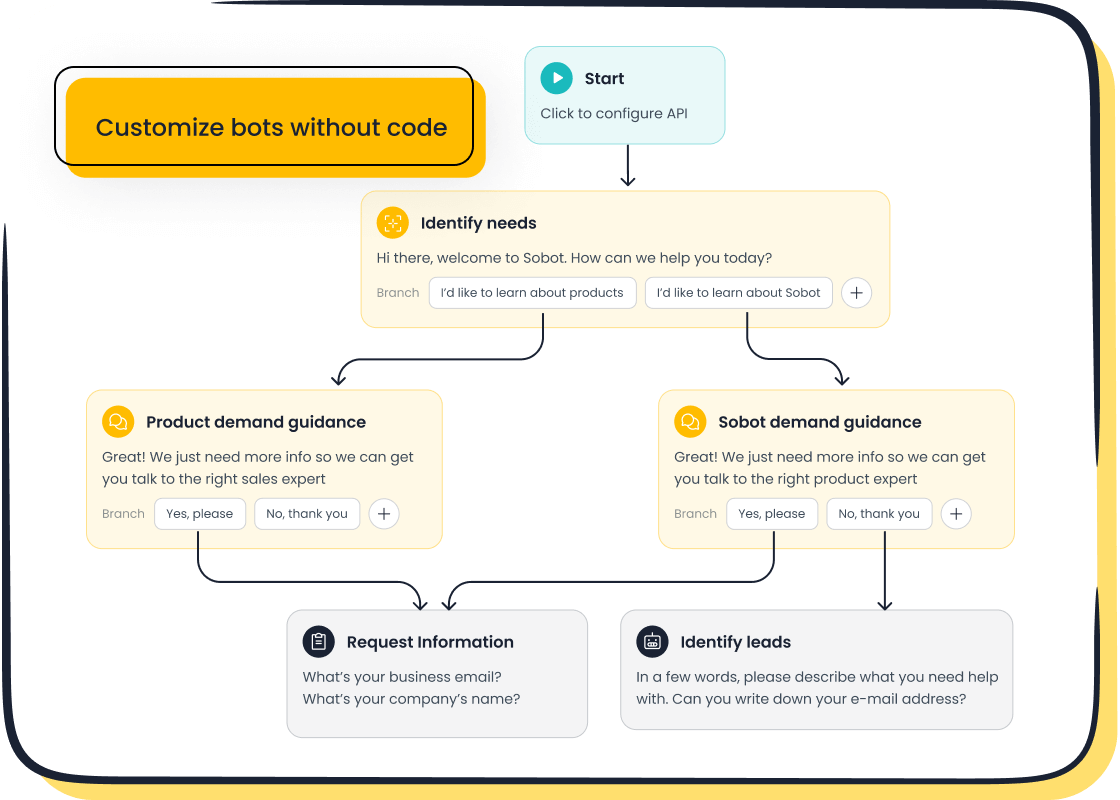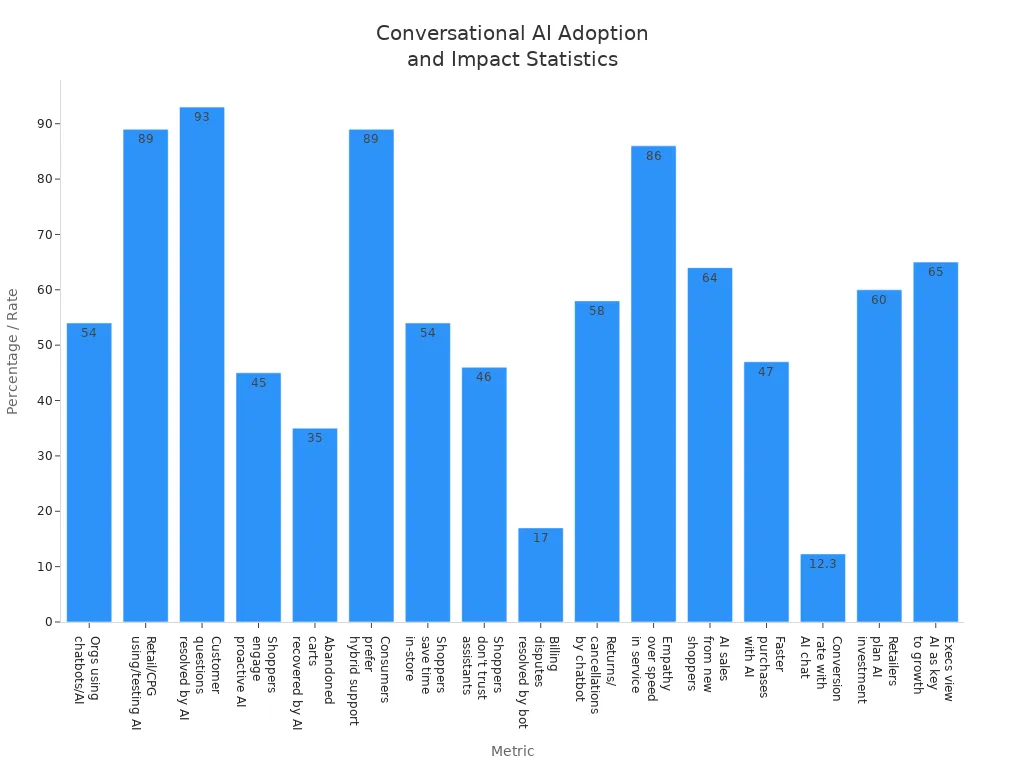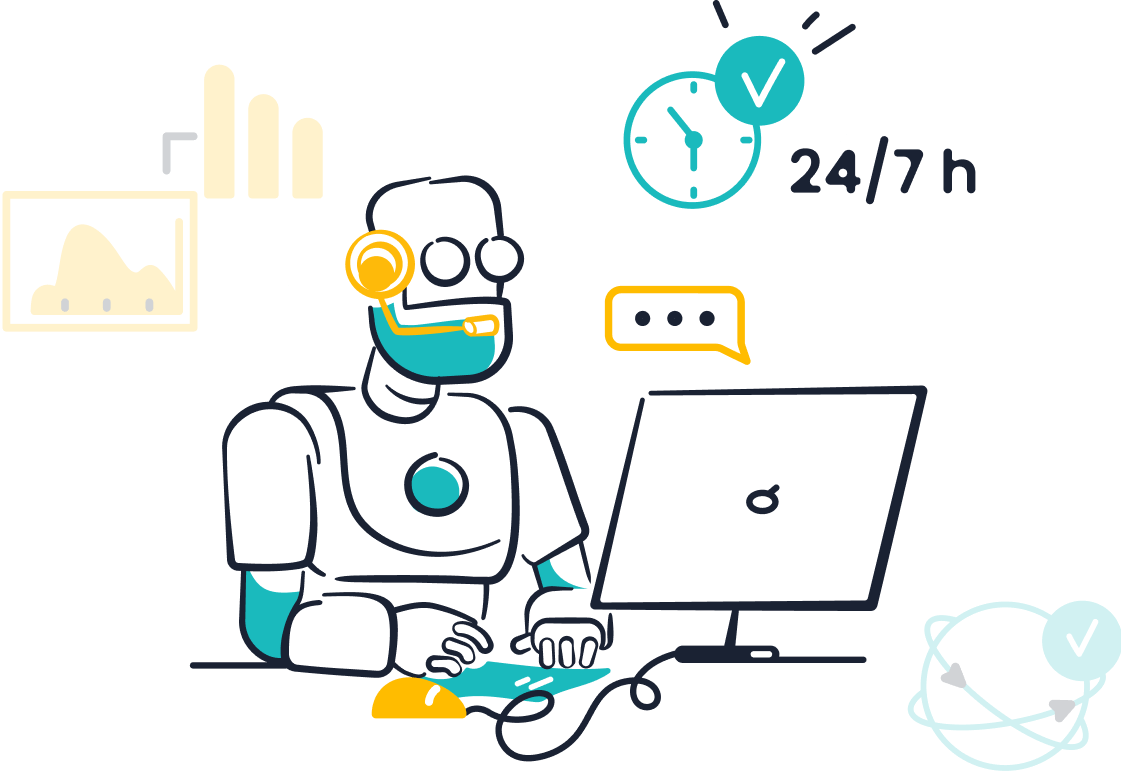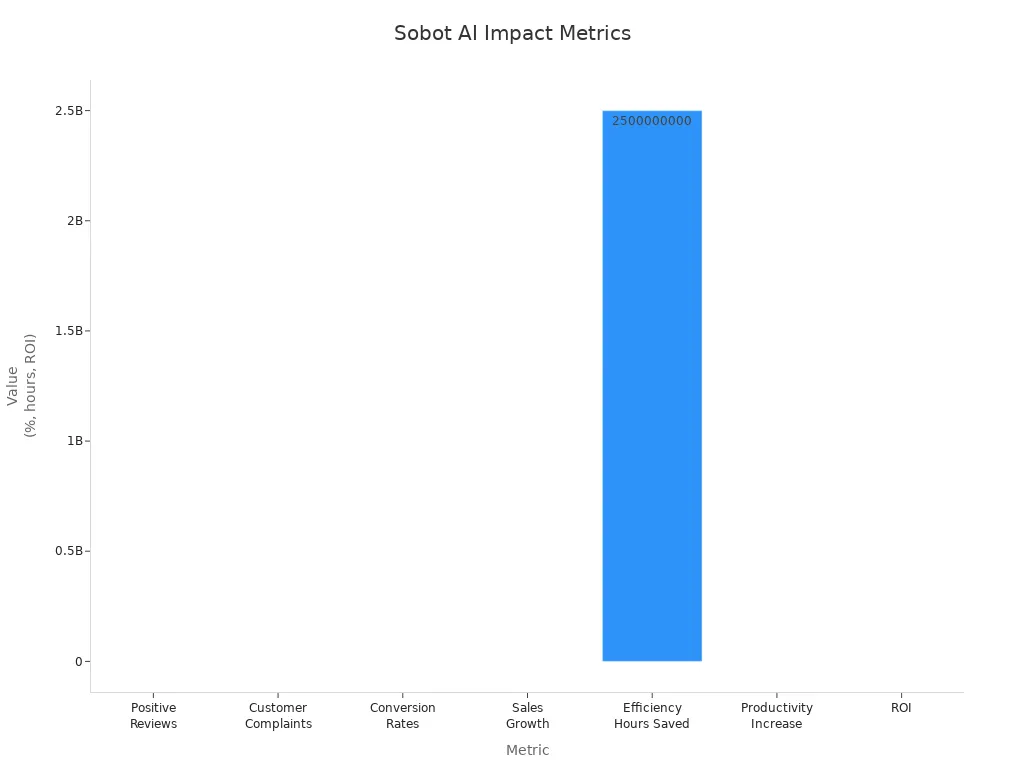Conversational AI vs Chatbot How Each Works Step by Step

You’ve likely heard the terms conversational AI vs chatbot, but it’s important to understand the distinction. While chatbots typically follow predefined scripts to handle simple tasks, conversational AI, like Sobot AI, comprehends natural language, learns from interactions, and tackles more complex problems. This difference is crucial for customer service and e-commerce, where shoppers expect fast, personalized assistance. Sobot offers both solutions, allowing you to select the best fit for your business needs. Additionally, Sobot call center integrates these technologies to provide seamless, efficient customer support. Here’s how companies are leveraging these tools today:
| Metric | Statistic | Description |
|---|---|---|
| Organizations using chatbots or conversational AI | 54% | Customer-facing roles (Gartner) |
| Companies using or testing AI in retail and CPG | 89% | Actively using or piloting AI (NVIDIA) |
| Customer questions resolved by AI without human help | 93% | AI chatbot success rate (Rep AI report) |

Key Differences
Conversational AI vs Chatbot
You might wonder what sets conversational AI vs chatbot apart. Chatbots work by following rules and scripts. They answer simple questions and help with basic tasks. If you ask a chatbot something outside its script, it may not understand. Chatbots use keyword matching, so you need to phrase your question just right.
Conversational AI takes things further. It uses natural language processing and machine learning. This means conversational AI can understand what you mean, even if you ask in different ways. It learns from each conversation and gets better over time. You get responses that feel more human and less robotic.
Let’s look at a quick comparison:
| Aspect | Chatbots | Conversational AI |
|---|---|---|
| Language Processing | Rule-based, keyword matching | Natural language understanding |
| Learning Capabilities | No self-improvement | Learns and adapts over time |
| Response Generation | Fixed templates | Personalized, dynamic responses |
| Conversation Management | Each chat is isolated | Remembers context across chats |
| Integration | Limited | Connects with business systems easily |
| Business Impact | Lower satisfaction, more escalations | Higher resolution, better customer experience |
Chatbots handle lots of simple requests fast. Conversational AI can solve complex problems and keep track of past chats. This difference matters for customer service and customer engagement.
Why It Matters
When you choose between conversational AI vs chatbot, think about your goals. Chatbots are great for quick answers and saving time. They help with FAQs and simple tasks. You can set up a chatbot fast and start seeing results.
Conversational AI boosts customer engagement and customer experience. It remembers what you said before and gives smarter answers. This leads to happier customers and better retention. Businesses using conversational AI see higher sales and improved customer service. For example, companies like Sephora and H&M use AI to give personalized recommendations, which increases engagement and sales.
Tip: If you want to scale your support and connect with customers on many channels, conversational AI is the way to go. It can handle more requests and work with your existing systems.
Chatbots and conversational AI both improve customer service, but conversational AI offers deeper engagement and smarter support. Your choice affects how customers feel about your brand and how well your team works.
Chatbot Basics
What Is a Chatbot
You see chatbots everywhere now. They pop up on websites, apps, and even social media. A chatbot is a computer program that talks with you using text or voice. You ask a question, and the chatbot gives you an answer. Chatbots help you find information, solve problems, and get things done faster.
Chatbots do more than just answer simple questions. They remember past chats, spot when you change topics, and ask for more details if your message is unclear. Chatbots use conversation history to make smart choices. They can give you answers that fit your needs and even learn from each chat. Some chatbots work with text, voice, or both, and they keep working even when lots of people use them at once.
Here’s what chatbots can do for you:
- Handle routine questions and tasks
- Give instant replies, day or night
- Collect info about you to help with future chats
- Guide you through purchases or support steps
- Keep your brand’s voice consistent
- Help with customer support, sales, and even HR tasks
- Transfer your chat to a human if things get tricky
- Boost customer engagement and loyalty
Chatbots make life easier for you and your business. They save time, cut costs, and help you serve more people at once.
Sobot Chatbot Features

If you want a chatbot that does more, Sobot Chatbot stands out. You get omnichannel support, so your chatbot talks to customers on WhatsApp, Facebook, Instagram, SMS, email, and more. Everything comes together in one place, making customer support simple.
Sobot Chatbot speaks many languages. You can reach customers worldwide, and the chatbot works 24/7. You don’t need to code to set up your chatbot. Just use the point-and-click interface to build your chatbot and automate tasks.
Check out how Sobot Chatbot compares:
| Feature Aspect | Sobot Chatbot | Market Average |
|---|---|---|
| Omnichannel Support | Centralizes chats from all major channels | Limited channel integration |
| Multilingual | 24/7 service in multiple languages | Often single language |
| No-Code Setup | Easy point-and-click design | Coding often required |
| AI Integration | Powered by advanced AI and LLMs | Basic AI or rule-based |
| Reporting | Detailed analytics and optimization tools | Basic reporting |
Sobot Chatbot helps you automate customer support, boost sales, and collect leads. You get a chatbot that grows with your business and keeps customers happy.
Chatbot Steps

User Input
When you start a chat with a chatbot, you type or speak your question. This could be anything from “What are your store hours?” to “How do I track my order?” Chatbots like Sobot can handle customer inquiries from many channels at once—websites, WhatsApp, SMS, and more. You don’t have to wait in line or call a support number. The chatbot is always ready to listen, day or night.
Processing
Once you send your message, the chatbot gets to work. It breaks your input into smaller parts, like words or phrases. This step is called tokenization. The chatbot then cleans up the text, making everything lowercase and removing extra words that don’t matter. Next, it uses natural language processing (NLP) to figure out what you want. Sobot’s chatbot uses advanced AI and machine learning to recognize your intent, even if you ask in different ways. It checks for important details, like dates or order numbers, to make sure it understands your request.
Response
After understanding your question, the chatbot decides how to reply. It looks for the best answer in its knowledge base or uses templates to build a response. Some chatbots use rules, while others, like Sobot, use AI to create more natural replies. The chatbot sends you an answer in seconds—much faster than waiting for a human agent. Studies show chatbots can cut response times from minutes to just a few seconds, which keeps customers happy and boosts conversion rates.
Sobot Chatbot in Action
Let’s see how Sobot’s chatbot helps with customer support. Imagine you ask about a product return. The chatbot quickly checks your order details, explains the return steps, and even sends you a return label—all in one chat. Sobot’s chatbot handles thousands of customer inquiries at once, never gets tired, and works 24/7. This means you get instant help, and businesses see improved efficiency and big cost savings. With Sobot, you can trust that your chatbot will keep your customers satisfied and your support team focused on more complex issues.
Conversational AI Overview

What Is Conversational AI
You might wonder what makes conversational ai chatbots different from regular ai chatbots. Conversational ai uses smart technologies to help you talk to computers just like you talk to people. These systems rely on natural language processing, machine learning, and large language models. You can ask questions, get answers, and even have full conversations.
Here’s how conversational ai works:
- Machine learning helps conversational ai chatbots learn from every interaction.
- Natural language processing lets the system understand what you mean, even if you use slang or make mistakes.
- Speech-to-text and automatic speech recognition turn your voice into text.
- Text-to-speech gives you spoken replies.
- Large language models, like GPT-3, help conversational ai chatbots generate human-like responses.
- Dialogue management keeps track of your conversation, so the chatbot remembers what you said before.
These conversational ai platforms use advanced tools to make your experience smooth and natural. You get answers that feel personal and accurate.
Conversational AI Chatbots
Conversational ai chatbots do more than just answer simple questions. They understand context, remember past chats, and give you dynamic replies. You can ask about products, get help with orders, or even receive personalized recommendations. Conversational ai chatbots use natural language processing to figure out your intent and respond in a way that feels human.
Let’s look at how conversational ai chatbots work step by step:
- You speak or type your question.
- The system uses speech recognition or text analysis to understand your words.
- Natural language understanding figures out what you want.
- The chatbot uses large language models to create a reply.
- Dialogue management keeps the conversation flowing.
- The chatbot remembers your previous questions and tailors its answers.
You get conversational experiences that feel real and helpful. Conversational ai chatbots are perfect for customer service, sales, and support.
Sobot AI Solutions
Sobot’s conversational ai solutions help you run your retail or ecommerce business better. You can use conversational ai chatbots across chat, voice, social media, email, and SMS. Sobot’s conversational ai for customer service answers questions 24/7, gives personalized recommendations, and solves problems fast.
Sobot ai chatbots use natural language processing and large language models to deliver accurate, human-like replies. You get AI agents and voicebots that handle repetitive tasks, freeing your team to focus on complex issues. Sobot’s conversational ai platforms support dynamic pricing, inventory management, and product customization. You can see all your customer interactions in one place and use AI insights to improve your operations.
Sobot’s conversational ai applications help you boost sales, reduce cart abandonment, and keep customers happy. The AI-driven voicebot can handle more than half of your inbound calls and support outbound marketing campaigns. Sobot’s conversational ai software keeps your data safe and meets global privacy standards.
Tip: If you want to improve customer satisfaction and grow your business, Sobot’s conversational ai chatbots are a smart choice. You get seamless support, smarter recommendations, and better results.
| Sobot Conversational AI Use Cases | Benefit |
|---|---|
| 24/7 Customer Support | Faster answers, happier shoppers |
| Personalized Recommendations | Higher sales, better engagement |
| Automated Order Tracking | Less manual work, fewer errors |
| Voicebot for Calls | Improved efficiency, more sales |
| AI Copilot for Agents | Quicker replies, less stress |
You can see how conversational ai chatbots and conversational ai platforms make a big difference in retail and ecommerce. Sobot’s conversational ai tools help you deliver better conversational experiences and drive business growth.
Conversational AI Steps
Input Understanding
When you chat with conversational ai chatbots, the first step is input understanding. You type or speak your question, and the ai chatbots get to work. They use natural language processing to break down your words and figure out what you mean. This process helps conversational ai chatbots spot your intent and pick out important details, like dates or product names.
Here’s how the process usually works:
- You send a message to the ai chatbots.
- The system uses natural language processing to analyze your words.
- Conversational ai chatbots identify your intent and any key information.
- They match your question to the right answer or action.
This step is important because it helps conversational ai chatbots understand what you want, even if you ask in different ways. You don’t have to use perfect grammar or spelling. The ai chatbots can still figure it out.
Context Management
Context management is what makes conversational ai chatbots feel smart. These ai chatbots remember what you said earlier in the chat. They use machine learning and natural language processing to keep track of your questions and answers. This means conversational ai chatbots can handle multi-step conversations without losing track.
- Conversational ai chatbots use past customer interactions to personalize replies.
- They connect with business systems to pull up your order history or account info.
- Context management helps conversational ai chatbots give you answers that make sense, even if you switch topics.
You get a smooth experience because the ai chatbots don’t ask you to repeat yourself. This makes customer interactions faster and more enjoyable.
Note: Context management also helps conversational ai chatbots reduce mistakes and speed up problem-solving.
Intelligent Response
After understanding your input and context, conversational ai chatbots generate a reply. These ai chatbots use advanced models, like transformers and neural networks, to create responses that sound natural. They don’t just pull answers from a script. Instead, conversational ai chatbots use natural language processing and machine learning to build replies that fit your question and the conversation flow.
- Dialogue management keeps the chat on track.
- Natural language generation helps conversational ai chatbots sound more human.
- The ai chatbots adjust their answers based on your mood or previous messages.
This step makes customer interactions feel real. You get answers that are clear, helpful, and personal.
Learning and Optimization
Conversational ai chatbots never stop learning. Every time you chat, the ai chatbots collect data and look for ways to improve. They use machine learning to spot patterns in customer interactions. Over time, conversational ai chatbots get better at understanding what you want and how to help.
- The ai chatbots review past chats to find common questions.
- They update their models to handle new topics or tricky questions.
- Data collection and insights help conversational ai chatbots improve accuracy and speed.
You benefit from smarter ai chatbots that keep getting better. Businesses see higher satisfaction and more efficient customer interactions.
Conversational AI vs Chatbot Comparison
Workflow Differences
When you look at how chatbots and conversational ai work behind the scenes, you see some big differences. Chatbots follow a set path. They use scripts and decision trees to answer questions. If you ask something outside their script, they might get stuck. Conversational ai, on the other hand, adapts to your needs. It learns from every chat and can handle more complex conversations.
Here’s a table that shows the main workflow differences:
| Aspect | Chatbots (Rule-Based) | Conversational AI |
|---|---|---|
| Workflow Flexibility | Fixed scripts for simple, repetitive tasks | Dynamic, context-aware, adapts to user intent |
| Conversation Handling | Linear, menu-driven, struggles with interruptions | Handles multi-step, complex chats, keeps context |
| Personalization | Static responses, little to no personalization | Personalized replies at scale, learns user preferences |
| Learning Capability | Manual updates needed | Learns and improves from every interaction |
| Integration | Basic connections, limited system integration | Deep integration with CRMs, ERPs, and more |
| Scalability | Hard to scale beyond scripts | Built for enterprise, handles high volumes |
| User Experience | Rigid, no context retention | Human-like, remembers context, refines responses |
You can see that conversational ai chatbots give you a smoother, more natural experience. They remember what you said earlier and adjust their answers as the chat goes on. This makes your customer interactions feel more like talking to a real person.
Let’s break down what this means for your business:
- Conversational ai connects with your CRM and other systems, so you can automate tasks with simple messages.
- You can use conversational ai to create leads, schedule meetings, or pull reports—all in one chat.
- These ai chatbots work around the clock, so your team and customers always get help.
- They pull info from different sources, making onboarding and training easier.
- You get fewer mistakes and more consistent answers.
- As your business grows, conversational ai platforms scale up without needing more staff.
Note: If you want workflows that grow with your business and make life easier for your team, conversational ai is the way to go.
Capabilities
Chatbots and conversational ai chatbots both help with customer engagement, but their abilities are very different. Chatbots stick to what they know. They use keywords and scripts to answer questions. If you ask something new, they might not know what to do.
Conversational ai uses machine learning, NLP, and deep learning. It understands what you mean, even if you don’t use the exact words. It can sense your mood and adjust its tone. These ai chatbots remember past chats and give you answers that fit your needs.
Here’s what conversational ai can do that chatbots can’t:
- Understands intent, context, and even your mood.
- Gives dynamic, personalized replies based on your history.
- Handles long, multi-turn conversations without losing track.
- Supports many languages and can switch between them.
- Connects with your business systems for real-time info.
- Learns from every chat, so it gets smarter over time.
Chatbots, on the other hand:
- Use fixed rules and scripts.
- Only answer structured, simple questions.
- Don’t learn from chats, so they stay the same.
- Struggle with open-ended or complex questions.
- Can’t personalize answers beyond basic info.
If you want to deliver personalized customer service and boost customer engagement, conversational ai chatbots are the better choice. They help you create engaging, human-like conversations that keep customers coming back.
Tip: Conversational ai for customer service lets you support customers in their language, on their favorite channel, and with answers that feel personal.
Use Cases
You can use chatbots and conversational ai in many ways, but some tasks fit one better than the other. Chatbots work best for simple, repeatable jobs. Conversational ai shines when you need deeper engagement and smarter support.
Common chatbot use cases:
- Answering FAQs
- Order tracking
- Booking appointments
- Collecting basic info
- Routing chats to human agents
Conversational ai use cases:
- Running loyalty programs with personalized messages and rewards
- Nurturing leads with targeted content and follow-ups
- Sending automated updates about orders, stock, and promotions
- Providing 24/7 customer support across chat, voice, and social media
- Giving personalized product recommendations
- Collecting feedback and analyzing customer sentiment
- Handling complex queries about products, shipping, or returns
- Supporting the entire buying journey, from product questions to aftercare
Real-world brands use conversational ai chatbots to boost engagement and sales. For example, Sephora’s virtual assistant gives custom product tips, while Walmart’s voice agent helps with easy ordering. These conversational ai platforms help you create conversational experiences that feel real and helpful.
Note: You can measure success with metrics like resolution rate, customer satisfaction, and conversion uplift. Conversational ai chatbots help you improve all of these.
Sobot Customer Story: OPPO
Let’s see how a global brand uses Sobot’s solutions to improve customer experience and engagement. OPPO, a leader in smart devices, faced a big challenge. During shopping festivals, customer inquiries spiked. Their team struggled to keep up, and customers had to wait longer for help.
OPPO decided to use Sobot’s ai chatbots and chatbot solutions. The results were impressive. Sobot’s chatbot handled repetitive questions, freeing up human agents for more complex issues. This made customer support faster and more efficient.
After switching to Sobot, OPPO saw an 83% chatbot resolution rate. That means most questions got solved without a human stepping in. Customer satisfaction soared, with a 94% positive feedback score. OPPO also noticed a 57% increase in repurchase rate, showing that better engagement leads to more loyal customers.
Sobot’s system made it easy for OPPO to update features. When OPPO needed a new function, Sobot delivered it in just one day. Their previous provider took six months for similar changes. This agility helped OPPO stay ahead in a fast-moving market.
“Sobot’s ai chatbots helped us serve customers better and faster. Our team can now focus on what matters most—building great customer relationships.” — OPPO
You can read more about OPPO’s journey with Sobot here.
If you want to boost customer engagement, improve customer experience, and scale your support, Sobot’s conversational ai chatbots and chatbot solutions can help. You get smarter, faster, and more personal customer interactions—just like OPPO.
Choosing between a chatbot and conversational ai depends on your goals. Here’s what you should remember:
- Chatbots use rules and scripts for simple tasks and FAQs.
- Conversational ai uses advanced tech like machine learning and NLU for natural, complex conversations.
- Conversational ai supports multi-channel, personalized interactions and learns over time.
- Chatbots work well for basic needs, while conversational ai fits businesses seeking better customer experience and efficiency.
Sobot’s solutions help you boost customer experience, increase sales, and save time. Check out the impact:

Think about your needs, then explore Sobot’s chatbot and conversational ai tools to get the best results for your customer service.
FAQ
What is the main difference between a chatbot and conversational AI?
A chatbot follows scripts and rules. Conversational AI understands natural language and learns from every chat. You get smarter, more human-like conversations with conversational AI.
Can conversational AI chatbots handle multiple languages?
Yes! Conversational AI chatbots can talk to you in many languages. This helps you connect with customers around the world and makes support easier for everyone.
How do chatbots improve customer service?
Chatbots answer questions fast, day or night. You get instant help with simple tasks like order tracking or FAQs. This saves you time and keeps your customers happy.
Is it hard to set up a chatbot or conversational AI for my business?
No, it’s easy! Many platforms, like Sobot, offer no-code tools. You can build and launch a chatbot or conversational AI without needing to write any code.
When should I choose conversational AI over a regular chatbot?
Pick conversational AI when you want smarter, more personal chats. If your business needs to handle complex questions or remember past conversations, conversational AI is the best choice.
See Also
Simple Steps To Deploy Chatbot Examples On Websites
How To Select The Ideal Chatbot Software Solution
Building A Chatbot That Drives Website Success
